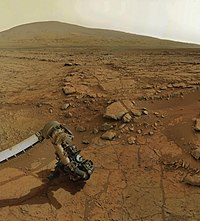Habitability of neutron star systems

 |
| This article is one of a series on: |
| Life in the universe |
|---|
| Outline |
| Planetary habitability in the Solar System |
|
| Life outside the Solar System |
|
| Habitability of... |
|
The habitability of neutron star systems is the potential of planets and moons orbiting a neutron star to provide suitable habitats for life.[1]
A habitable planet orbiting a neutron star must be between one and 10 times the mass of the Earth. If the planet were lighter, its atmosphere would be lost. Its atmosphere must also be thick enough to convert the intense X-ray radiation emanating from the parent star into heat on its surface. Then it could have the temperature suitable for life.[1]
A magnetic field strong enough — the magnetosphere — would protect the planet from the strong solar winds. This could preserve the planet's atmosphere for several billion years. Such a planet could have liquid water on its surface.[1]
A Dutch research team published an article on the subject in the journal Astronomy & Astrophysics in December 2017.[2][3]
See also
- Habitability of red dwarf systems
- Habitability of K-type main-sequence star systems
- Habitability of natural satellites
- Dragon's Egg and its sequel Starquake, novels by Robert L. Forward, about life on a neutron star itself.
References
- ^ a b c Suominen, Mikko. "Tutkimus spekuloi pulsaria ympäröivien planeettojen elinkelpoisuudella" [The study speculates on the viability of the planets surrounding the pulsar]. Tähdet ja avaruus; in translation "Stars and space" (in Finnish). Helsinki: Tähtitieteellinen yhdistys Ursa (Ursa Astronomical Association). ISSN 0355-9467. Archived from the original on 2018-03-28. Retrieved 2022-10-07.
According to a Dutch research team, a planet orbiting a neutron star may be surprisingly suitable for life. In other words, liquid water could exist on the planet's surface. The original text: Hollantilaisen tutkimusryhmän mukaan neutronitähteä kiertävä planeetta saattaa hämmästyttävää kyllä sopia elämälle. Toisin sanoen planeetan pinnalla voisi esiintyä nestemäistä vettä.
- ^ Patruno, Alessandro; Kama, Mihkel (2017). "Neutron star planets: Atmospheric processes and irradiation" (PDF). Astronomy & Astrophysics. 608 (A147). EDP Sciences.: A147. arXiv:1705.07688. Bibcode:2017A&A...608A.147P. doi:10.1051/0004-6361/201731102. ISSN 1432-0746. Archived from the original on 2018-07-27.
p. 9: It is thus possible to speculate that the wind could completely miss the planets orbiting around the pulsar because of a geometric misalignment of the orbital plane with respect to the ion current sheet or negative charge flow.
- ^ "Habitable planets around pulsars theoretically possible". astron.nl. Netherlands Institute for Radio Astronomy (ASTRON). 2017-12-19. Archived from the original on 2022-10-07. Retrieved 2022-10-07.
In the future, the astronomers would love to observe the pulsar in more detail and compare it with other pulsars. The ALMA telescope of the European Southern Observatory would be able to show dust discs around neutron stars.











